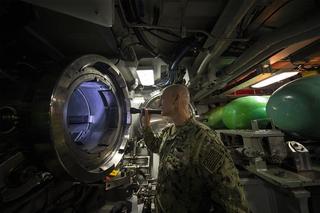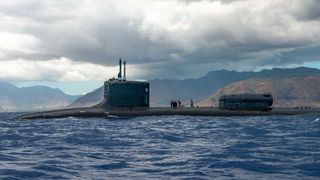One of the criticisms of the AUKUS announcement in September 2021 was that the argument for why Australia needed a nuclear-powered submarine was not run and won by the Morrison government. With the announcement of the optimal pathway, criticism continues in some circles that the Albanese government, like its predecessor, is yet to make a definitive case for the capability.
It could be argued that this is fairly typical of recent government announcements of major defence acquisitions. Such announcements have often been big on headlines, short on details and absent a strategic rationale other than the broadest of brush strokes about the changing strategic order or more dangerous international circumstances. In addition, Australian governments have been hesitant to publicly address the perceived threat driving increases in defence spending, capability development and preparedness. Given the poor state of the bilateral relationship with Australia’s largest trading partner in recent years, as well as regional sensitivities, it is little wonder that they have not directly noted these developments are largely in response to a country starting with C and ending with A that is not Canada, Cuba or Cambodia.
Why submarines? Geography, concepts, and strategy
Amongst pundits, it is rare to hear criticism of Australia maintaining a submarine capability as part of the Australian Defence Force (ADF). As a maritime nation dependent on international trade for its economic survival and standard of living, a strong and capable navy is seen as an essential element of Australia’s defence force. Indeed, the establishment of the Royal Australian Navy in 1911 was seen as one of the first significant moments in generating a self-reliant defence capability for Australia. In the contemporary debate, submarine capabilities are seen as ‘significant to every element and stage’ of Australia’s maritime security.
As the current Chief of Navy, Vice-Admiral Mark Hammond, recently noted ‘Sea lines of communication are the lifeblood of this nation, and in that context the Navy and its submarine capability is imperative.’
The ADF is required to ‘control our air and sea approaches against credible adversaries…to the extent required to safeguard our territory, critical sea lanes, population and infrastructure.’ This is a long-standing theme in Australian strategy that goes back to pre-federation times. It is a product of one of the key drivers of strategy — geography. With only one country on an island continent, Australia’s land borders are settled. Its engagement with other nations thus lies beyond the seas.
This is significant as ninety-nine per cent of Australian trade comes (and goes) via cargo ships. Ninety-five per cent of Australia’s telecommunications — digital, and internet — come in via undersea cable. Australia has the world’s third-largest maritime exclusive economic zone, covering 8.2 million square kilometres. The economic and conservation value of this zone is considerable, as it contains oil and gas fields, fisheries and shipping lanes.
As a trading nation, the security of Australia’s maritime approaches is essential to its national survival, peace and prosperity. As the current Chief of Navy, Vice-Admiral Mark Hammond, recently noted ‘Sea lines of communication are the lifeblood of this nation, and in that context the Navy and its submarine capability is imperative.’
A key element of Australian defence policy is the development of strategic concepts. Concepts are important in strategy as they help to describe a method or scheme for employing military capabilities towards the achievement of a stated aim. Self-reliance in the context of Australia’s relationship with its major power allies – firstly Great Britain and then the United States – has been a key longstanding concept for Australian defence policy. The contemporary understanding of self-reliance was framed by the 1969 Nixon Doctrine, which emphasised that United States allies in Asia should take on more responsibility for their own defence short of a threat of a major power involving nuclear weapons.
During the 1970s and 1980s, this led Australia to develop the concept of the Defence of Australia. Core to this approach was the notion of self-reliance within the context of the United States Alliance. During this period Australian Defence policy brought forward two of the most seminal Australian strategic documents, the 1986 Dibb Review and the 1987 Defence White Paper delivered by then-Defence Minister Kim Beazley. These documents outlined that the balance of threat faced by Australia was assessed as low.
Remote from the global geostrategic centre of gravity and thus the frontlines of the Cold War, these two key strategic documents focused on the potential for the emergence of a low-level or escalated low-level threat against Australia from within Australia’s immediate region. This meant that Australia should be prepared to defend the continent against low-level and escalated low-level threats without relying on the combat forces of the United States.
The defence of Australia has had an enduring impact on how Australian strategy has been conceived and how major capability decisions have been executed. The defence force was designed around the notion that to achieve security the Australian Defence Force must maintain a regional military capability edge. This capability edge was core to how a very large island nation with a very small population and defence force could provide credible deterrence and response options. Key to this idea was the notion that quality – of technology, platforms, capabilities, operations and people – over quantity was the key. The foundation of this approach was the US alliance. Access to cutting-edge US intelligence, technology and capabilities would ensure that Australia had the most advanced military in the region. One of the centrepieces of the maintenance of a regional military capability edge was to provide the ADF with a regionally superior submarine capability.
While the risk of conflict was seen as remote in the 1980s and the threat basis was driven by low-level conflict, the 1987 Defence White Paper honed in on a key long-term defence planning notion: Australia’s maritime geography. The paper noted that ‘ranging across the levels of conflict addressed in Australian defence planning is the issue of threat to Australian trade by attempted interdiction of shipping on our trade routes and in proximate ocean areas.’
In recent decades Australia’s, and the Indo-Pacific’s, strategic situation has changed radically. The strategic risk is no longer low and the threat has moved from low-level conflict to the potential for a high-end major war in Australia’s region.
One of the keys to addressing this perennial geo-strategic issue was that Australia’s submarine capability, both present and future, must have long-range and endurance and the ability to operate independently and effectively even in areas where a potential adversary ‘might have air superiority.’ Given Australia’s geography, the currency of this approach endures. As the 2016 Defence White Paper noted, ‘Submarines are an essential part of Australia’s naval capability, providing a strategic advantage in terms of surveillance and protection of our maritime approaches.’
Unifying Australia’s strategic approach in the period from the 1970s was the undergirding primacy of the United States in the Indo-Pacific. US maritime supremacy in the Indo-Pacific during this period along with a robust, interlinked series of Australian defence strategic concepts help to maintain peace and prosperity and allowed for modest investments in defence capability. Unfortunately, the supposed ‘peace dividend’ taken at the end of the Cold War, despite it not being the basis of Australian defence planning, has eroded cumulative defence investment. This was, however not seen as overly significant at the time as we entered a period post-1989 of the United States as the ‘unipolar power’.
In recent decades Australia’s, and the Indo-Pacific’s, strategic situation has changed radically. The strategic risk is no longer low and the threat has moved from low-level conflict to the potential for a high-end major war in Australia’s region.
A new strategic reality
The 2020 Defence Strategic Update (DSU) made it clear that the era of low-level threats was over. The rise of China, as well as India and Indonesia in the Indo-Pacific, has changed the strategic balance. The United States is no longer the hegemon of the region. The DSU laid out a convergence of issues and concluded that ‘major power competition [between China and the United States] has intensified and the prospect of high-intensity conflict in the Indo-Pacific, while still unlikely, is less remote than in the past.’ Most significantly it ended another key defence planning concept – 10 years of warning time for major conflict.
Increased strategic competition and the transition of the locus of global strategic power from Europe to the Indo-Pacific, with its maritime rather than continental geography, means that the utility of submarines has not been lost on other nations in the region. The People’s Republic of China have 58 submarines, and this is expected to grow to 76 by the 2030s. Over the last 15 years, China has constructed 12 nuclear boats. Japan is increasing its fleet from 16 to 22 conventionally powered submarines. South Korea, India, Pakistan, Thailand, Philippines, Indonesia, Vietnam, Taiwan and Singapore have all either been expanding, modernising or acquiring submarines.
Increased strategic competition and a proliferation of submarines, especially Chinese nuclear-powered (and nuclear-armed) boats, means that the capability edge of Australia’s current Collins-class submarines is rapidly eroding. At the time of the AUKUS announcement in September 2021, then-Prime Minister Scott Morrison noted that ‘A conventional diesel-powered submarine was not going to meet Australia’s strategic requirements…we formed the very strong view, the unanimous view of all the Chiefs of our services and Defence Force, that this was a capability that was not going to meet our needs.’
The rapid and massive expansion of China’s naval capability in tandem with its increasingly aggressive, coercive and revisionist approach to the region has further compressed timelines to increasing deterrence.
With the changing threat environment, Australia can no longer rely on maintaining a regional military capability edge across the board in the face of a rising major power. Australia, the United States and its allies and partners must focus their efforts on key military technology areas that make an asymmetric difference. This cuts across AUKUS Pillar I (nuclear-powered submarines) and AUKUS Pillar II (advanced capabilities).
The rapid and massive expansion of China’s naval capability in tandem with its increasingly aggressive, coercive and revisionist approach to the region has further compressed timelines to increasing deterrence. While AUKUS Pillar I Nuclear Powered Submarines (SSN) is a multi-decade project AUKUS Pillar 2 Advanced Capabilities focused on providing rapid technological advances for military capabilities as a solution to the rapidly decreasing timelines for contingency scenarios.
For AUKUS Pillar I, as a Center for Strategic and International Studies report to Congress eight years ago concluded, despite the changing military balance-of-power in the Pacific the United States still retains a 15-year lead in submarine capabilities over adversaries. For a maritime nation like Australia, such an advantage is critical. SSNs will make an asymmetrical difference for Australia and the regional military balance.
Australia cannot do this alone. The development of a nuclear industry and advanced manufacturing base is only possible because the United States and Great Britain will share their technology and their expertise. This is only possible because the United States and Great Britain see Australia’s acquisition of this sovereign capability as essential to their own security. The Albanese government is determined to build the sovereign capabilities needed to defend Australia and as US Studies Centre surveys show 60 per cent of the American public agree that Australia’s capabilities make America safer too.
The United States is not transferring nuclear propulsion technology and pulling Virginia-class boats off the production line for financial reasons. The US strategic rationale is even starker when you consider the shortage of attack class submarine capability in the US Navy at present. The US approach is being driven by their own strategy of integrated deterrence which seeks, in part, to significantly increase the capabilities of key US allies. The bottom line is that the United States understands that greater Australian deterrence capability reinforces regional stability and US security. For the United Kingdom, the rising importance of the Indo-Pacific is a key factor, but so too is the advantage of pooling resources that allow economies of scale and faster innovation in undersea warfare for all three maritime democracies.

Operational advantages of conventional v. nuclear: Why nuclear-powered submarines?
The debate in Australia around AUKUS is not really about submarine capability at all. Most defence commentators and analysts accept the merits of submarine capability. Rather the debate revolves around nuclear versus conventional power.
For some commentators such as Professor Hugh White from The Australian National University and Sam Roggeveen from the Lowy Institute, the question is not really about propulsion. Rather propulsion is a proxy for discussions of the operational use of the capability. As White stated ‘if Australia’s submarines were intended primarily to defend Australia and our closer neighbours, then there is no way we’d consider nuclear propulsion.’ Roggeveen agreed, arguing that if ‘Australia believes it needs the capability to defend the Australian continent alone, then this is the wrong decision.’
Both White and Roggeveen argue that the primary role of an SSN is ‘to operate off the coast of China in co-operation with the US Navy.’ Thus, their role is to support US primacy rather than Australia’s defence. Their argument is, however, based on conjecture rather than evidence. Most significantly, it overlooks the outsized benefits of an SSN capability in waters closer to Australia and the inherent mission flexibility that an SSN capability provides to the Australian Government.
But as technology and surveillance capabilities increase and the region becomes more contested, conventionally powered submarines – especially for a country with such vast maritime spaces and distances as Australia – are becoming more vulnerable.
The current Collins class of conventionally-powered submarines has been the centrepiece of maritime operations for Australia for decades. But as technology and surveillance capabilities increase and the region becomes more contested, conventionally powered submarines – especially for a country with such vast maritime spaces and distances as Australia – are becoming more vulnerable.
Conventionally-powered submarines are restricted in range by their diesel fuel tanks. Their ability to maintain stealth is dependent on limited battery life. And to keep those batteries charged, they must come close to the surface to re-charge them by running their diesel engines through a snorkel.
The transition to an SSN capability provides for an exponential increase in speed, manoeuvrability, survivability, and endurance. They are also vastly more lethal, being able to deliver long-range missiles, much deeper magazines and the ability for vertical launch missiles. An SSN’s ability to maintain high speeds over extended periods means they can get from one place to another quickly and provide a broader range of mission profiles, all while remaining submerged and undetected for months on end.
As a Center for Strategic and Budgetary Assessments report noted in 2013, the enhanced endurance of an SSN over a conventionally-powered boat means that their time on station at key choke points to Australia almost triples. Their additional range provides vastly more options to government for their employment, and their speed, endurance and stealth provide for an exponential increase of capability, and thus deterrence, against any adversary.
In addition, as Australian Rear Admiral (Ret.) Peter Briggs has noted, an SSN’s reactor provides ‘electrical power generation capacity [that] offers significant advantages in powering sensors and command, control, intelligence and combat systems and allows it to operate as a mothership or hub for remotely operated unmanned devices.’
Thus, the move to nuclear-powered submarines represents a quantum leap in technology for the Australian submarine force – an essential factor in providing the ADF with an asymmetric regional military capability edge in a critical technology area against the backdrop of great power competition.
It is for exactly these reasons that other US allies like Japan and South Korea have also considered acquiring nuclear-powered submarines, despite their close proximity to China, North Korea and Russia. SSNs have value beyond just long-range operations by enabling longer time on station as well as secure counter-strike capabilities to uphold deterrence.
The challenge ahead
With brutal Russian aggression in Ukraine and China’s growing strategic interest in the Indian Ocean and the Pacific, Australia did not really have the option to ignore the most important capability available to secure the maritime domain. Nations that also depend on maritime security like Japan, India and Singapore understand exactly what Australia is doing. States who have been subjected to intense disinformation campaigns about AUKUS will be the ultimate beneficiaries of a deterrence capability that makes the initiation of conflict much less attractive to any adversary in the region.
AUKUS is huge – it is the most significant joint build of a maritime platform since the United States transferred nuclear propulsion technology to the UK in 1958. There will be complex hurdles to overcome –from reforming the labyrinth of export control rules in the United States to assembling the workforce needed in Australia. Australia will have to put deterrence platforms in the water while the new SSNs are being designed and built, and a combination of autonomous undersea vehicles and planned US submarines will help to fill that gap.
But ultimately, the political leadership of all three countries did not travel halfway around the world to declare a pathway for something that they think cannot be built-- or that does not enjoy strong bipartisan support in the United States, UK and Australia.
Perhaps that demonstration of unity and resolve is as powerful a signal of deterrence as the technologies the three leaders announced.






